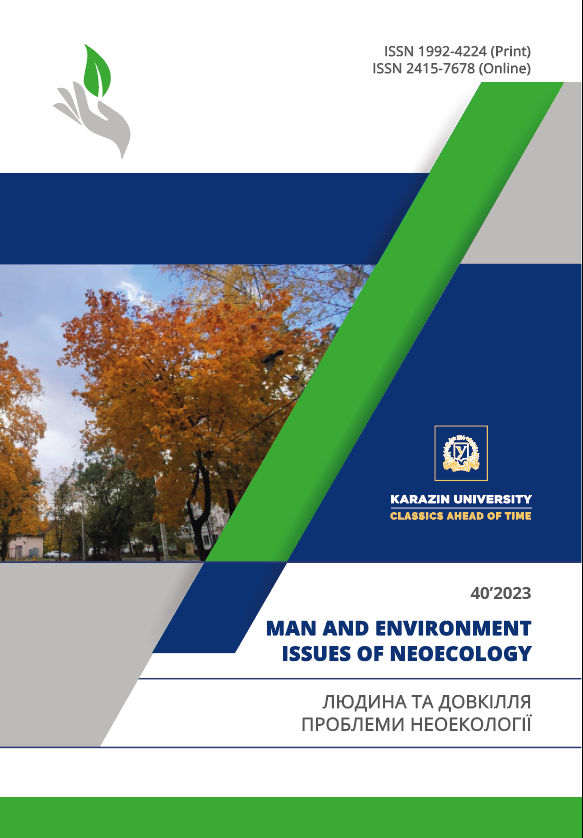Environmental conservation based on Mamar system as local wisdom of West Timor, East Nusa Tenggara
Abstract
Purpose. To analyze the environmental conservation practices based on the Mamar system as local wisdom and related social structures as a mechanism for environmental conservation in West Timor, East Nusa Tenggara.
Results: Mamar system has persisted since the 17th century since it is applied with mechanisms and approaches to the needs of local communities for the preservation of natural resources in the long and sustainable term. This system is applied by cultivating land for perennials, food crops, fodder crops, and livestock rearing.. Environmental conservation is implemented on the basis of the local principles such as Bua, Nuni, and Bunu. The local customary regulations were set and supervised by the guards called Mataf and Ketiut Po’an, in which the individuals who violated the regulations will get a sanction called Tasane. By adhering to the local belief system, the community naturally consider that their action in taking a use of natural resources wisely is part of maintaining the sustainability. Besides, the local community also pursue the harmonious relationship with the inhabitants of a particular forest area or spring through ritual ceremonies.
Conclusions: Practically, Mamar can be interpreted as an “artificial oasis: built by Amarasi local community in West Timor as a strategy to adapt in the adverse environmental conditions. Mamar system sustained the socio-economic and cultural life of the Amarasi community through its’ ecological, economic and social variables. The conservation based on Mamar system is carried out and maintained by applying the local values that are authentic, straightforward and measurable in accordance with the situation and conditions of the community
Downloads
References
James, R., Gibbs, B., Whitford, L., Leisher, C., Konia, R., & Butt, N. (2021). Conservation and Natural Resource Management: Where are All the Women? Oryx, 55(6), 860–867. https://doi.org/https://doi.org/10.1017/S0030605320001349
Ataupah, H. (2020). Ekologi dan Masyarakat, Kajian dan Refleksi Atoin Meto Di Timor Barat, NTT ((G. Neonba). CV Sejahtera Mandiri Teknik Indonesia.
Putra, L. M. (2021). Igya Ser Hanjop, Pengelolaan Ruang Ekologi Suku Arfak. ECONUSA Nature Culture Conservation. https://econusa.id/id/ecoblog/igya-ser-hanjop-pengelolaan-ruang-ekologi-suku-arfak/
Habiyaremye, A., & Korina, L. (2021). Indigenous Knowledge Systems in Ecological Pest Control and Post-Harvest Rice Conservation Techniques: Sustainability Lessons from Baduy Communities. Sustainability, 13(16). https://doi.org/https://doi.org/10.3390/su13169148
Purnamawati, I. G. A. (2021). Strengthening Local Institutional Identity Through Traditional Village Management. Target: Jurnal Manajemen Bisnis, 3(1).
Eghenter, C., Widodo, K., Bawan, Y., Jalung, S., & Salo, A. (2021). Tana’ ulen A Vital Conservation Tradition for the Recognition of Territories of Life.
Bansard, J., & Schroder, M. (2021). The Sustainable Use of Natural Resources: The Governance Challenge.
Pörtner, H. O., Scholes, R. J., Agard, J., Archer, E., Arneth, A., Bai, X., & Ngo, H. (2021). Scientific outcome of the IPBES-IPCC co-sponsored workshop on biodiversity and climate change. IPBES-IPCC co-sponsored workshop.
Godoi, M., & Pacheco, J. (2016). Sustentabilidade e Abordagem Sistemica: Reconsiderando o Triple Bottom Line. Conference: 12o Congresso Brasileiro de Sistemas, 1–29.
Bogdan, R., & Biklen, S. K. (2007). Qualitative Research for Education. Pearson A & B.
Bungin, B. (2020). Post-qualitative social research methods: kuantitatif-kualitatif-mix methods positivism-post-positivism-phenomenology-postmodern : filsafat, paradigma, teori, metode dan laporan (1st ed.). Kencana.
Maxwell, J. A. (2012). Qualitative Research Design: An Interactive Approach (3rd Editio). SAGE Publications, Inc.
Elmusharaf, D. K. (2012). 3) Qualitative Data Collection Techniques.
Kirk, S., & Hinton, D. (2019). “I’m not what I used to be”: A qualitative study exploring how young people experience being diagnosed with a chronic illness. Child Care Health Dev, 45(2), 216–226. https://doi.org/10.1111/cch.12638
Schwartz-Shea, P. (2012). Interpretive Research Design Concepts and Processes (1st ed.). Routledge.
Manafe, John, A. D., & Notohadiprawiro, P. D. I. T. (1990). Ekosistem “mamar” sebagai suatu bentuk wanatani tradisional di Kabupaten Kupang, Nusa Tenggara Timur. Universitas Gadjah Mada.
Dawson, N., Coolsaet, B., Sterling, E., Loveridge, R., D, N., Gross-Camp, Wongbusarakum, S., Sangha, K., Scheri, L., Phan, H. P., Zafra-Calvo, N., Lavey, W., Byalagaba, P., Idrobo, C. J., Chenet, A., Bennett, N., Mansourian, S., & Rosado-May, F. (2021). The role of Indigenous peoples and local communities in effective and equitable conservation. Ecology and Society, 26(3).
Baines, G. (1982). Traditional conservation practices and environmental management: the international scene. In In Traditional Conservation in Papua New Guinea: Implications for Today (pp. 45–57). Institute of Applied Social and Economic Research.
Pernetta, J. C., & Hill, L. (1984). Traditional Use and Conservation of Resources in the Pacific Basin. The South Pacific, 13(5/6), 359–364.
Shackeroff, J. M., & Campbell, L. (2007). Traditional Ecological Knowledge in Conservation Research: Problems and Prospects for their Constructive Engagement. Conservation and Society, 5(3), 343–360.
AS, E., Aliyudin, M., Laksana, M. W., Nurdin, F. S., Muslimah, S. R., & Azis, W. D. I. (2020). Sunda Wiwitan: The Belief System of Baduy Indigenous Community, Banten, Indonesia. Wawasan: Jurnal Ilmiah Agama Dan Sosial Budaya, 5(1), 77–95.
Copyright (c) 2023 G. Lewoleba, B. Widianarko , Y. T. N. Dewi

This work is licensed under a Creative Commons Attribution 4.0 International License.
Authors reserve the right of attribution for the submitted manuscript, while transferring to the Journal the right to publish the article under the Creative Commons Attribution License 4.0 International (CC BY 4.0). This license allows free distribution of the published work under the condition of proper attribution of the original authors and the initial publication source (i.e. the Journal)
Authors have the right to enter into separate agreements for additional non-exclusive distribution of the work in the form it was published in the Journal (such as publishing the article on the institutional website or as a part of a monograph), provided the original publication in this Journal is properly referenced
The Journal allows and encourages online publication of the manuscripts (such as on personal web pages), even when such a manuscript is still under editorial consideration, since it allows for a productive scientific discussion and better citation dynamics (see The Effect of Open Access).





